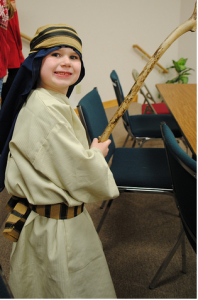Directing a program can overwhelm. In arranging the details and giving instructions, support an atmosphere of calm.
Even with preparing in advance, I still get bombarded with questions and suggestions that did not cross my mind.
Knowing my framework assists me in fielding these questions and deciding to add, remove, or change a previous choice.
Last week, I shared my planning process for directing the children’s play for my son’s school Christmas program where two-thirds of the process is planning.
The first third, covered in Part 1, focused on the script, set, and properties. Upon gaining momentum with the framework in place, I move to the second third of the planning process, the cast and crew, costumes, and lighting.
Cast and Crew
Though thought-out and working on paper, you need people to execute, put feet to your plan. Recognizing your limitations and your strengths can guide you to find a cast and crew to balance you.
For me, working with children is hard. Dealing with the talking, wiggling, giggling, and goofing-off distracts others and wastes time. To keep myself focused, I plan extra help during rehearsals to handle these distractions. With this extra aid, I make progress while using time wisely.
The cast and crew for this production included the following:
- The student actors
- Playwrights
- Adaptors
- Director
- Choir directors
- Costume Engineer
- Lighting Engineer
- Pianist
- Parent Volunteers
The Cast
The cast received assigned parts for this production. Via e-mail, parents responded if their child wanted an acting part. From the feedback received, I (with help) assigned the actors to a part.
The actors received their scripts before Thanksgiving break. With the extra time, most of the actors had their lines memorized during the first week of rehearsal.
The Crew
Comprised of parent volunteers, the crew helped pin sticky notes with children’s names on costumes, brought in items for our set, and assisted with crowd control during rehearsals. By never turning away help, I kept a list of To-Do items. When asked if I needed help, I had an answer.
With the cast and crew chosen, I began working with the costume engineer.
Costumes
The mom who helps as the costume engineer is fantastic. She brings creativity and energy to the project. With a list in hand, she and I sort through the school’s costumes. Placing the garments, head pieces, and sashes together, we make notes of items we are missing.
Then we borrowed, made, or purchased more items for the cast members. Adjustments to the hems, fasteners, and accessories came after the actors’ fittings. But getting organized early and planning for dress rehearsal gets us closer to a successful performance.
Lighting
Though limited in lighting options, I chose to create a simple light plot with 6 cues. Working in a church auditorium with groups of lights controlled by one switch gets tricky. No matter what the limitations, you can still make the most of the situation. My lighting design will not win any awards. However, the simple design creatively followed the action.
With the cast and crew, the costumes, and the lighting design chosen, the framework is complete. This framework is the road map to get from start to finish. The last step is executing this plan, covered next week in Part 3.
In planning your next event, ask for help. While planning and executing, you will have a friend along with whom to interact, laugh, and share. Enjoy the calm of the event by using time wisely to organize. Happy planning!
Question: How often do you ask for help when planning an event? Please add your answer to the comments.
